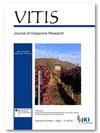应用X射线计算机断层扫描技术对葡萄根系进行高分辨率三维表型分析
IF 1.1
4区 农林科学
Q3 HORTICULTURE
引用次数: 2
摘要
植物根系对水分和养分的吸收至关重要,对植物对环境胁迫的反应也起着重要作用。作为植物隐藏的一半,对根系的研究是极具挑战性的,大多数现有的方法都是破坏性的,而且非常劳动密集型。在这项概念验证研究中,采用非侵入性x射线微计算机断层扫描(x射线µCT)方法研究了葡萄根复杂三维(3D)结构的表型变化作为基因型和土壤的函数。“Calardis Musque”、“Villard Blanc”和V3125(“Schiava Grossa”和“Riesling”)的木本扦插在聚丙烯柱中,用两种不同的土壤类型(粘土壤土和砂壤土)种植6周。之后,使用x射线微CT技术对柱进行一次扫描。对接收到的原始数据进行分析,重建三维根系模型(3D模型),以42µm的空间分辨率显示完整、完整的根系的非破坏性可视化。利用三维模型对18株被调查植物的根系特征进行定量分析,通过测量木材砍伐过程中相对于水平轴的不定根长度、侧根长度、总根长度、根系表面积、根系体积和根系生长角度来精确量化根系特征。结果表明:(1)不同基因型间根的早期形成和根的生长存在差异,特别是‘卡拉迪斯Musque’和‘维拉德Blanc’;(ii)土壤类型对V3125不定根的形成有影响,但对'Calardis Musque'和'Villard Blanc'的影响较小。综上所述,这种创新的高分辨率x射线微CT技术适用于葡萄扦插根形成、结构和根系特征的非破坏性高分辨率表型分析,例如研究根系对干旱胁迫的反应,并为根瘤蚜根系侵染提供新的见解。本文章由计算机程序翻译,如有差异,请以英文原文为准。
High-resolution 3D phenotyping of the grapevine root system using X-ray Computed Tomography
Plant roots are essential for water and nutrient uptake and contribute to the plants' response to environmental stress factors. As the hidden half of a plant, investigation of root systems is highly challenging, most of available methods are destructive and very labour-intensive. In this proof-of-concept study, a non-invasive X-ray micro computed tomography (X-ray µCT) method was applied to investigate the phenotypic variation of the complex three-dimensional (3D) architecture of grapevine roots as a function of genotype and soil. Woody cuttings of 'Calardis Musque', 'Villard Blanc' and V3125 ('Schiava Grossa' x 'Riesling') were cultivated in polypropylene columns filled with two different soil types, clay loam and sandy loam, for 6 weeks. Afterwards, the columns were scanned once using the technique of X-ray µCT. The received raw data were analysed for the reconstruction of 3D root system models (3D model), which display a non-destructive visualization of whole, intact root systems with a spatial resolution of 42 µm. The 3D models of all investigated plants (in total 18) were applied to quantify root system characteristics precisely by measuring adventitious root length, lateral root length, total root length, root system surface area, root system volume and root growth angles from the woody cutting relative to a horizontal axis. The results showed that: (i) early root formation and root growth differed between genotypes, especially between 'Calardis Musque' and 'Villard Blanc'; and (ii) the soil type does influence adventitious root formation of V3125, but had minor effects on 'Calardis Musque' and 'Villard Blanc'. In conclusion, this innovative, high-resolution method of X-ray µCT is suitable for high resolution phenotyping of root formation, architecture, and rooting characteristics of grapevine woody cuttings in a non-destructive manner, e.g. to investigate root response to drought stress and would provide new insights into phylloxera root infection.
求助全文
通过发布文献求助,成功后即可免费获取论文全文。
去求助
来源期刊

Vitis
农林科学-园艺
CiteScore
1.80
自引率
0.00%
发文量
0
审稿时长
>36 weeks
期刊介绍:
VITIS publishes original scientific papers and critical reviews concerning grapevine biology, molecular biology, breeding, plant pathology, oenology and related fields. Research with a focus on pharmacology or post-harvest technology is not suitable for publication in VITIS.
 求助内容:
求助内容: 应助结果提醒方式:
应助结果提醒方式:


